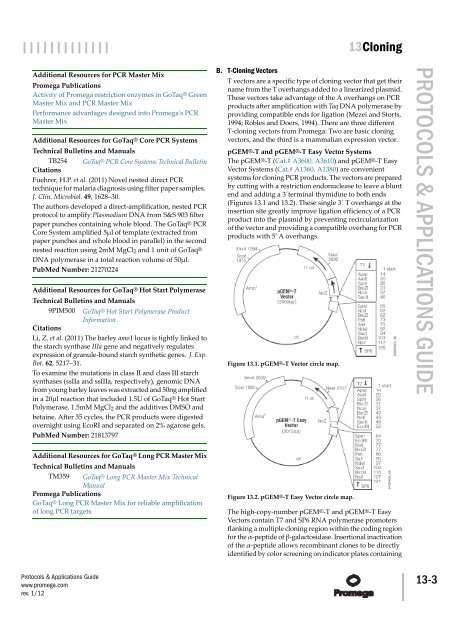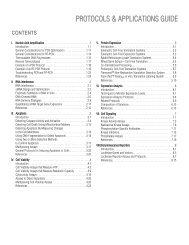Cloning Protocols and Applications Guide-A4 format - Promega
Cloning Protocols and Applications Guide-A4 format - Promega
Cloning Protocols and Applications Guide-A4 format - Promega
You also want an ePaper? Increase the reach of your titles
YUMPU automatically turns print PDFs into web optimized ePapers that Google loves.
||||||||||||| 13<strong>Cloning</strong><br />
Additional Resources for PCR Master Mix<br />
<strong>Promega</strong> Publications<br />
Activity of <strong>Promega</strong> restriction enzymes in GoTaq® Green<br />
Master Mix <strong>and</strong> PCR Master Mix<br />
Performance advantages designed into <strong>Promega</strong>'s PCR<br />
Master Mix<br />
Additional Resources for GoTaq® Core PCR Systems<br />
Technical Bulletins <strong>and</strong> Manuals<br />
TB254 GoTaq® PCR Core Systems Technical Bulletin<br />
Citations<br />
Fuehrer, H.P. et al. (2011) Novel nested direct PCR<br />
technique for malaria diagnosis using filter paper samples.<br />
J. Clin. Microbiol. 49, 1628–30.<br />
The authors developed a direct-amplification, nested PCR<br />
protocol to amplify Plasmodium DNA from S&S 903 filter<br />
paper punches containing whole blood. The GoTaq® PCR<br />
Core System amplified 5µl of template (extracted from<br />
paper punches <strong>and</strong> whole blood in parallel) in the second<br />
nested reaction using 2mM MgCl2 <strong>and</strong> 1 unit of GoTaq®<br />
DNA polymerase in a total reaction volume of 50µl.<br />
PubMed Number: 21270224<br />
Additional Resources for GoTaq® Hot Start Polymerase<br />
Technical Bulletins <strong>and</strong> Manuals<br />
9PIM500 GoTaq® Hot Start Polymerase Product<br />
In<strong>format</strong>ion<br />
Citations<br />
Li, Z. et al. (2011) The barley amo1 locus is tightly linked to<br />
the starch synthase IIIa gene <strong>and</strong> negatively regulates<br />
expression of granule-bound starch synthetic genes. J. Exp.<br />
Bot. 62, 5217–31.<br />
To examine the mutations in class II <strong>and</strong> class III starch<br />
synthases (ssIIa <strong>and</strong> ssIIIa, respectively), genomic DNA<br />
from young barley leaves was extracted <strong>and</strong> 50ng amplified<br />
in a 20µl reaction that included 1.5U of GoTaq® Hot Start<br />
Polymerase, 1.5mM MgCl2 <strong>and</strong> the additives DMSO <strong>and</strong><br />
betaine. After 35 cycles, the PCR products were digested<br />
overnight using EcoRI <strong>and</strong> separated on 2% agarose gels.<br />
PubMed Number: 21813797<br />
Additional Resources for GoTaq® Long PCR Master Mix<br />
Technical Bulletins <strong>and</strong> Manuals<br />
TM359 GoTaq® Long PCR Master Mix Technical<br />
Manual<br />
<strong>Promega</strong> Publications<br />
GoTaq® Long PCR Master Mix for reliable amplification<br />
of long PCR targets<br />
<strong>Protocols</strong> & <strong>Applications</strong> <strong>Guide</strong><br />
www.promega.com<br />
rev. 1/12<br />
B. T-<strong>Cloning</strong> Vectors<br />
T vectors are a specific type of cloning vector that get their<br />
name from the T overhangs added to a linearized plasmid.<br />
These vectors take advantage of the A overhangs on PCR<br />
products after amplification with Taq DNA polymerase by<br />
providing compatible ends for ligation (Mezei <strong>and</strong> Storts,<br />
1994; Robles <strong>and</strong> Doers, 1994). There are three different<br />
T-cloning vectors from <strong>Promega</strong>: Two are basic cloning<br />
vectors, <strong>and</strong> the third is a mammalian expression vector.<br />
pGEM®-T <strong>and</strong> pGEM®-T Easy Vector Systems<br />
The pGEM®-T (Cat.# A3600, A3610) <strong>and</strong> pGEM®-T Easy<br />
Vector Systems (Cat.# A1360, A1380) are convenient<br />
systems for cloning PCR products. The vectors are prepared<br />
by cutting with a restriction endonuclease to leave a blunt<br />
end <strong>and</strong> adding a 3´terminal thymidine to both ends<br />
(Figures 13.1 <strong>and</strong> 13.2). These single 3´ T overhangs at the<br />
insertion site greatly improve ligation efficiency of a PCR<br />
product into the plasmid by preventing recircularization<br />
of the vector <strong>and</strong> providing a compatible overhang for PCR<br />
products with 5′ A overhangs.<br />
Figure 13.1. pGEM®-T Vector circle map.<br />
Figure 13.2. pGEM®-T Easy Vector circle map.<br />
The high-copy-number pGEM®-T <strong>and</strong> pGEM®-T Easy<br />
Vectors contain T7 <strong>and</strong> SP6 RNA polymerase promoters<br />
flanking a multiple cloning region within the coding region<br />
for the α-peptide of β-galactosidase. Insertional inactivation<br />
of the α-peptide allows recombinant clones to be directly<br />
identified by color screening on indicator plates containing<br />
PROTOCOLS & APPLICATIONS GUIDE 13-3

















